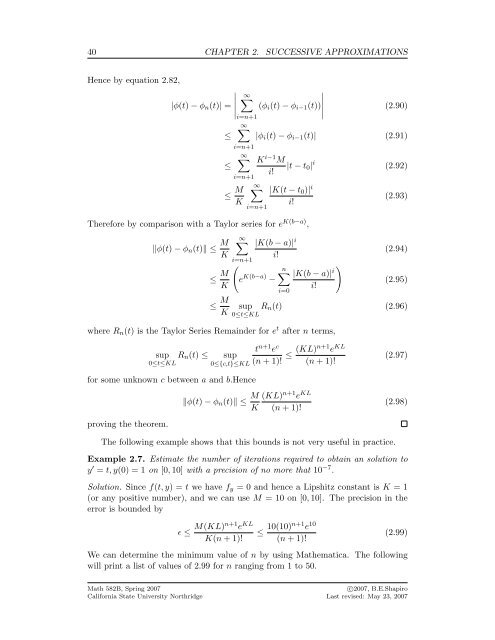The Computable Differential Equation Lecture ... - Bruce E. Shapiro
The Computable Differential Equation Lecture ... - Bruce E. Shapiro
The Computable Differential Equation Lecture ... - Bruce E. Shapiro
You also want an ePaper? Increase the reach of your titles
YUMPU automatically turns print PDFs into web optimized ePapers that Google loves.
40 CHAPTER 2. SUCCESSIVE APPROXIMATIONS<br />
Hence by equation 2.82,<br />
|φ(t) − φ n (t)| =<br />
∣<br />
≤<br />
≤<br />
≤ M K<br />
∞∑<br />
i=n+1<br />
∞∑<br />
i=n+1<br />
∞∑<br />
i=n+1<br />
(φ i (t) − φ i−1 (t))<br />
∣<br />
(2.90)<br />
|φ i (t) − φ i−1 (t)| (2.91)<br />
K i−1 M<br />
|t − t 0 | i (2.92)<br />
i!<br />
∞∑<br />
i=n+1<br />
|K(t − t 0 )| i<br />
<strong>The</strong>refore by comparison with a Taylor series for e K(b−a) ,<br />
i!<br />
(2.93)<br />
‖φ(t) − φ n (t)‖ ≤ M K<br />
≤ M K<br />
∞∑ |K(b − a)| i<br />
i!<br />
i=n+1<br />
(<br />
)<br />
n∑<br />
e K(b−a) |K(b − a)| i<br />
−<br />
i!<br />
i=0<br />
(2.94)<br />
(2.95)<br />
≤ M K<br />
sup R n (t) (2.96)<br />
0≤t≤KL<br />
where R n (t) is the Taylor Series Remainder for e t after n terms,<br />
sup R n (t) ≤<br />
0≤t≤KL<br />
sup<br />
0≤{c,t}≤KL<br />
t n+1 e c<br />
(n + 1)! ≤ (KL)n+1 e KL<br />
(n + 1)!<br />
(2.97)<br />
for some unknown c between a and b.Hence<br />
proving the theorem.<br />
‖φ(t) − φ n (t)‖ ≤ M K<br />
(KL) n+1 e KL<br />
(n + 1)!<br />
(2.98)<br />
<strong>The</strong> following example shows that this bounds is not very useful in practice.<br />
Example 2.7. Estimate the number of iterations required to obtain an solution to<br />
y ′ = t, y(0) = 1 on [0, 10] with a precision of no more that 10 −7 .<br />
Solution. Since f(t, y) = t we have f y = 0 and hence a Lipshitz constant is K = 1<br />
(or any positive number), and we can use M = 10 on [0, 10]. <strong>The</strong> precision in the<br />
error is bounded by<br />
ɛ ≤ M(KL)n+1 e KL<br />
K(n + 1)!<br />
≤ 10(10)n+1 e 10<br />
(n + 1)!<br />
(2.99)<br />
We can determine the minimum value of n by using Mathematica. <strong>The</strong> following<br />
will print a list of values of 2.99 for n ranging from 1 to 50.<br />
Math 582B, Spring 2007<br />
California State University Northridge<br />
c○2007, B.E.<strong>Shapiro</strong><br />
Last revised: May 23, 2007
















